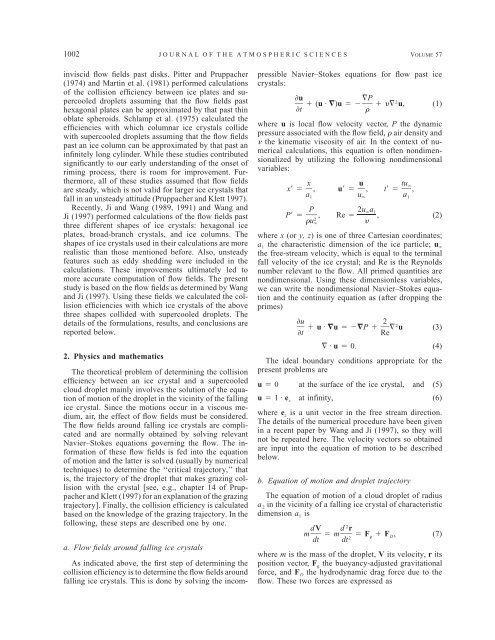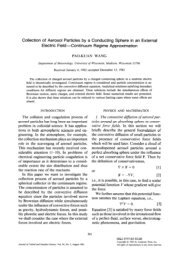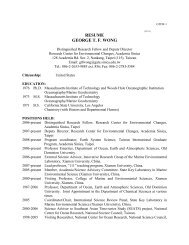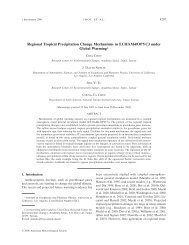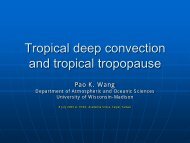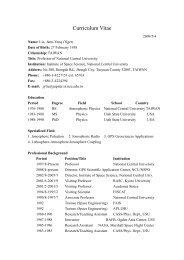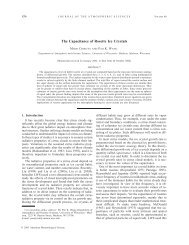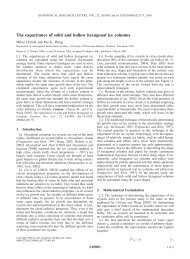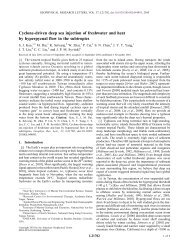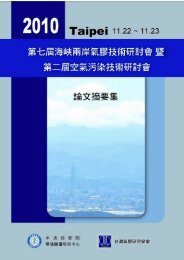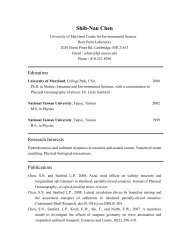Collision Efficiencies of Ice Crystals at LowâIntermediate Reynolds ...
Collision Efficiencies of Ice Crystals at LowâIntermediate Reynolds ...
Collision Efficiencies of Ice Crystals at LowâIntermediate Reynolds ...
Create successful ePaper yourself
Turn your PDF publications into a flip-book with our unique Google optimized e-Paper software.
1002 JOURNAL OF THE ATMOSPHERIC SCIENCESVOLUME 57inviscid flow fields past disks. Pitter and Pruppacher(1974) and Martin et al. (1981) performed calcul<strong>at</strong>ions<strong>of</strong> the collision efficiency between ice pl<strong>at</strong>es and supercooleddroplets assuming th<strong>at</strong> the flow fields pasthexagonal pl<strong>at</strong>es can be approxim<strong>at</strong>ed by th<strong>at</strong> past thinobl<strong>at</strong>e spheroids. Schlamp et al. (1975) calcul<strong>at</strong>ed theefficiencies with which columnar ice crystals collidewith supercooled droplets assuming th<strong>at</strong> the flow fieldspast an ice column can be approxim<strong>at</strong>ed by th<strong>at</strong> past aninfinitely long cylinder. While these studies contributedsignificantly to our early understanding <strong>of</strong> the onset <strong>of</strong>riming process, there is room for improvement. Furthermore,all <strong>of</strong> these studies assumed th<strong>at</strong> flow fieldsare steady, which is not valid for larger ice crystals th<strong>at</strong>fall in an unsteady <strong>at</strong>titude (Pruppacher and Klett 1997).Recently, Ji and Wang (1989, 1991) and Wang andJi (1997) performed calcul<strong>at</strong>ions <strong>of</strong> the flow fields pastthree different shapes <strong>of</strong> ice crystals: hexagonal icepl<strong>at</strong>es, broad-branch crystals, and ice columns. Theshapes <strong>of</strong> ice crystals used in their calcul<strong>at</strong>ions are morerealistic than those mentioned before. Also, unsteadyfe<strong>at</strong>ures such as eddy shedding were included in thecalcul<strong>at</strong>ions. These improvements ultim<strong>at</strong>ely led tomore accur<strong>at</strong>e comput<strong>at</strong>ion <strong>of</strong> flow fields. The presentstudy is based on the flow fields as determined by Wangand Ji (1997). Using these fields we calcul<strong>at</strong>ed the collisionefficiencies with which ice crystals <strong>of</strong> the abovethree shapes collided with supercooled droplets. Thedetails <strong>of</strong> the formul<strong>at</strong>ions, results, and conclusions arereported below.2. Physics and m<strong>at</strong>hem<strong>at</strong>icsThe theoretical problem <strong>of</strong> determining the collisionefficiency between an ice crystal and a supercooledcloud droplet mainly involves the solution <strong>of</strong> the equ<strong>at</strong>ion<strong>of</strong> motion <strong>of</strong> the droplet in the vicinity <strong>of</strong> the fallingice crystal. Since the motions occur in a viscous medium,air, the effect <strong>of</strong> flow fields must be considered.The flow fields around falling ice crystals are complic<strong>at</strong>edand are normally obtained by solving relevantNavier–Stokes equ<strong>at</strong>ions governing the flow. The inform<strong>at</strong>ion<strong>of</strong> these flow fields is fed into the equ<strong>at</strong>ion<strong>of</strong> motion and the l<strong>at</strong>ter is solved (usually by numericaltechniques) to determine the ‘‘critical trajectory,’’ th<strong>at</strong>is, the trajectory <strong>of</strong> the droplet th<strong>at</strong> makes grazing collisionwith the crystal [see, e.g., chapter 14 <strong>of</strong> Pruppacherand Klett (1997) for an explan<strong>at</strong>ion <strong>of</strong> the grazingtrajectory]. Finally, the collision efficiency is calcul<strong>at</strong>edbased on the knowledge <strong>of</strong> the grazing trajectory. In thefollowing, these steps are described one by one.a. Flow fields around falling ice crystalsAs indic<strong>at</strong>ed above, the first step <strong>of</strong> determining thecollision efficiency is to determine the flow fields aroundfalling ice crystals. This is done by solving the incompressibleNavier–Stokes equ<strong>at</strong>ions for flow past icecrystals:u P2 (u · )u u, (1)twhere u is local flow velocity vector, P the dynamicpressure associ<strong>at</strong>ed with the flow field, air density and the kinem<strong>at</strong>ic viscosity <strong>of</strong> air. In the context <strong>of</strong> numericalcalcul<strong>at</strong>ions, this equ<strong>at</strong>ion is <strong>of</strong>ten nondimensionalizedby utilizing the following nondimensionalvariables:x u tu x , u , t ,a1 u a1P2u aP , Re 12, (2)uwhere x (or y, z) is one <strong>of</strong> three Cartesian coordin<strong>at</strong>es;a 1 the characteristic dimension <strong>of</strong> the ice particle; u the free-stream velocity, which is equal to the terminalfall velocity <strong>of</strong> the ice crystal; and Re is the <strong>Reynolds</strong>number relevant to the flow. All primed quantities arenondimensional. Using these dimensionless variables,we can write the nondimensional Navier–Stokes equ<strong>at</strong>ionand the continuity equ<strong>at</strong>ion as (after dropping theprimes)u 22 u · u P utRe(3) · u 0. (4)The ideal boundary conditions appropri<strong>at</strong>e for thepresent problems areu 0 <strong>at</strong> the surface <strong>of</strong> the ice crystal, and (5)u 1·ez<strong>at</strong> infinity, (6)where e z is a unit vector in the free stream direction.The details <strong>of</strong> the numerical procedure have been givenin a recent paper by Wang and Ji (1997), so they willnot be repe<strong>at</strong>ed here. The velocity vectors so obtainedare input into the equ<strong>at</strong>ion <strong>of</strong> motion to be describedbelow.b. Equ<strong>at</strong>ion <strong>of</strong> motion and droplet trajectoryThe equ<strong>at</strong>ion <strong>of</strong> motion <strong>of</strong> a cloud droplet <strong>of</strong> radiusa 2 in the vicinity <strong>of</strong> a falling ice crystal <strong>of</strong> characteristicdimension a 1 is2dV d rm m Fg F D, (7)dt dt 2where m is the mass <strong>of</strong> the droplet, V its velocity, r itsposition vector, F g the buoyancy-adjusted gravit<strong>at</strong>ionalforce, and F D the hydrodynamic drag force due to theflow. These two forces are expressed as


